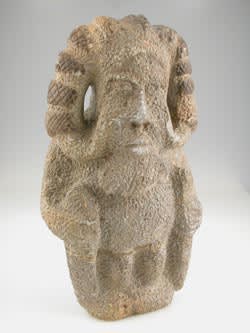Kissi Stone Pombo Sculpture of a Horned Man, 16th Century CE - 20th Century CE
Stone
11.5
PF.6059
Further images
The Kissi people revere stone anthropomorphic carvings found in fields and rivers in an area centered around the Sewa and Mano Rivers. They are called Pombo, meaning, “the deceased.” These...
The Kissi people revere stone anthropomorphic carvings found in fields and rivers in an area centered around the Sewa and Mano Rivers. They are called Pombo, meaning, “the deceased.” These carvings are extremely old and it was not until 1959 that Western scholars associated them with the so-called Afro-Portuguese ivory objects carved by artists of the Sapi kingdom. Although the Sapi kingdom collapsed in the 16th century, there art survived buried beneath the ground. Occasionally, these ancient works would be accidentally unearthed usually through flooding or farming. Kissi artists would often rework the Sapi sculptures, resulting in a multitude of variations of types and styles. This impressive work represents one of the more celebrated types; that of a mythical horned man. It is likely this figure depicts either a composite deity that is part human and part ram or a tribal chief wearing a horned crown. While either identity is possible, it is certain that this sculpture depicts a person of unquestionable authority and power. His head is disproportionate to the rest of his minimally rendered body. He stands alongside two staffs, another clear sign of his rank and authority. According to Kissi belief, such sculptures were thought to act as intermediaries between the living and their deceased ancestors. They would be worshiped on small altars or in deep bowls. This imposing sculpture, a literal relic of the past, continued to communicate with the lost world he left behind. Magically unearthed, he is a gift from the past to the present. The Kissi tribe frequently reworked such sculptures to update their themes and make them more relevant to their daily lives. However, the image of a horned man is a universal symbol of power that occurs is the art of most civilizations throughout history. This imposing work was surely as revered by the Kissi villagers who discovered it as by the Sapi artists who crafted it.





